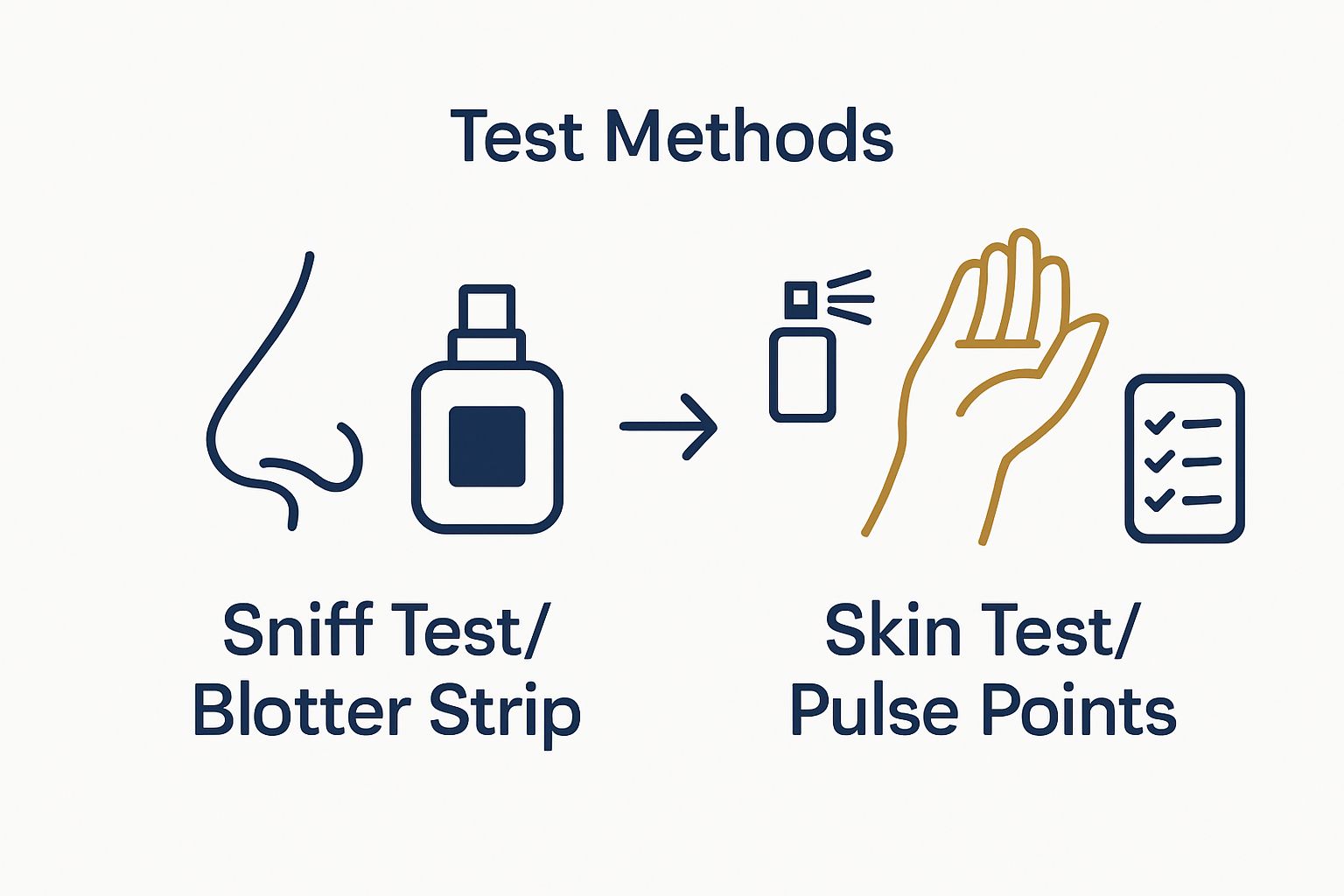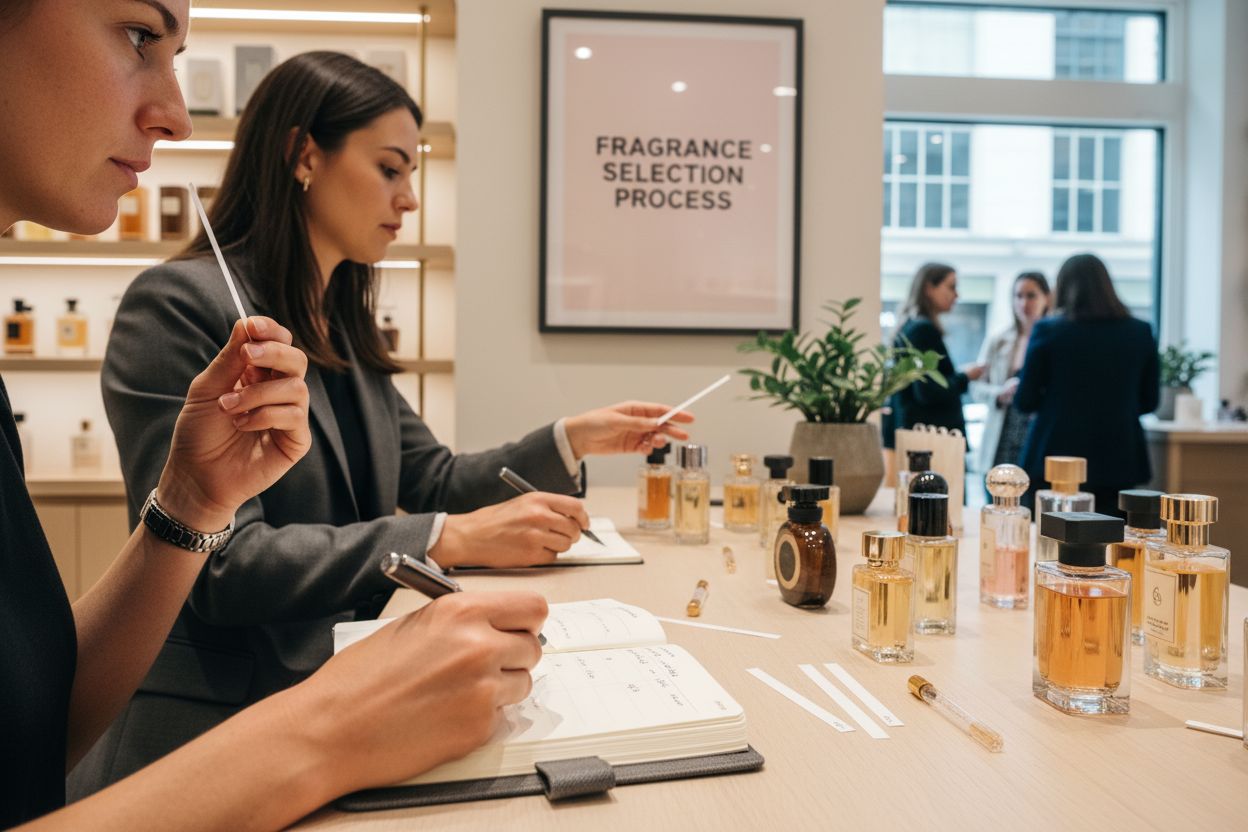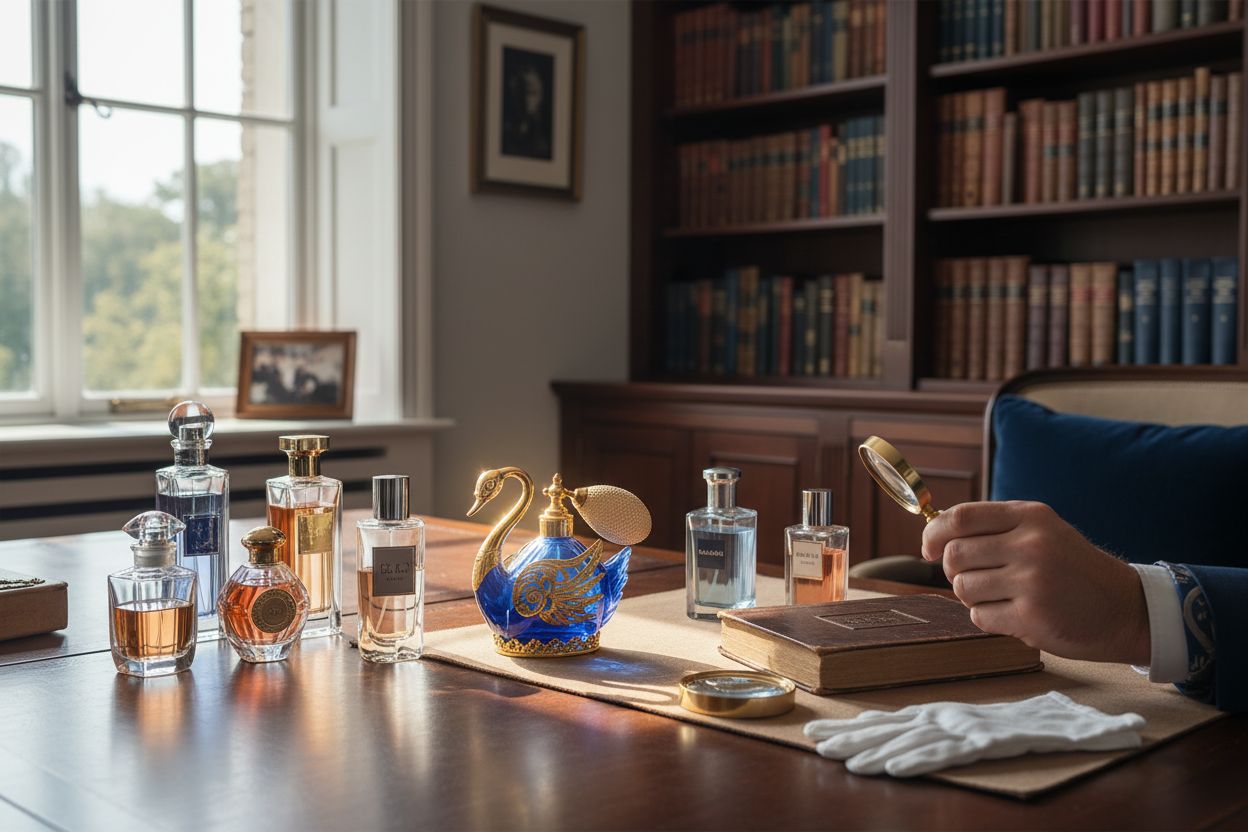Choosing your signature fragrance is more than picking a pretty bottle. Over 70 percent of people say scent stirs their strongest memories and emotions. Yet sampling perfumes on a strip rarely leads to the lasting satisfaction you expect. True discovery only happens when you blend curiosity with method and let your individuality guide the way.
Table of Contents
- Step 1: Identify Your Personal Fragrance Preferences
- Step 2: Research Fragrance Families And Notes
- Step 3: Test Fragrances On Skin For Accurate Evaluation
- Step 4: Evaluate Longevity And Sillage Of Selected Scents
- Step 5: Compare Options And Finalise Your Choice
Quick Summary
| Key Point | Explanation |
|---|---|
| 1. Reflect on personal scent history | Identify fragrances that have historically resonated with you to inform current preferences. |
| 2. Explore fragrance families systematically | Understand the main fragrance categories to enhance your selection process effectively. |
| 3. Test fragrances on skin for accuracy | Apply scents on pulse points to evaluate their true characteristics and personal fit. |
| 4. Evaluate longevity and sillage | Consider how long a fragrance lasts and its projection to ensure it meets personal needs. |
| 5. Compare choices before finalising | Create a comparison matrix to better assess your options before making a decision. |
Step 1: Identify your personal fragrance preferences
Discovering your signature scent starts with understanding your unique sensory landscape. The fragrance selection process is deeply personal, reflecting individual chemistry, emotional connections, and lifestyle preferences. According to research from the journal Applied Sciences, olfactory preferences are shaped by complex factors including genetics, early life experiences, and individual biology.
Begin by reflecting on scents that have historically resonated with you. Consider the fragrances you’ve enjoyed in the past - were they fresh and crisp like morning dew, warm and spicy like autumn evenings, or delicate and floral like a spring garden? Your personal history provides critical insights into your aromatic preferences. Trace your scent memories: think about perfumes that made you feel confident, comfortable, or emotionally uplifted.
Next, explore the intricate world of fragrance families. Some individuals naturally gravitate towards woody and earthy notes, while others prefer light, citrusy compositions. Take time to sample different fragrance types at boutiques or through sample sets. Pay attention to how each scent interacts with your skin chemistry - what smells divine on a display might transform differently when worn personally. Learn more about exploring fragrance families to refine your understanding.
Practical exploration is key to identifying your preferences. Create a sensory journal documenting your reactions to various scents. Note down not just the fragrance name, but how it makes you feel, its longevity on your skin, and the emotional responses it triggers. This methodical approach transforms fragrance selection from a random choice to an intentional, personalized experience.
Remember that your fragrance preference isn’t static. It evolves with your personal growth, changing seasons, and life stages. Approach your fragrance journey with curiosity and openness, allowing yourself to be pleasantly surprised by unexpected aromatic discoveries.
Step 2: Research fragrance families and notes
Understanding the intricate world of fragrance composition transforms your perfume selection from guesswork to strategic choice. According to Fragrantica, fragrances are complex symphonies composed of distinctive notes that evolve over time, creating unique sensory experiences.
Fragrance families represent fundamental categories that help categorize scent profiles. Four primary fragrance families dominate the perfume landscape: floral, oriental, woody, and fresh. Each family carries distinct characteristics that appeal to different sensibilities. Floral fragrances evoke delicate flower essences, oriental scents deliver warm and spicy impressions, woody notes capture earthy and robust sensations, while fresh fragrances provide crisp and clean impressions.
To effectively research fragrance notes, develop a systematic approach. Start by exploring online resources, visiting specialty perfume shops, and collecting sample sets. Discover the nuanced world of fragrance notes through methodical sampling and sensory exploration. Pay attention to how different notes interact - top notes provide initial impressions, heart notes create the fragrance’s core character, and base notes determine the scent’s lasting impression.
Experimental sampling is crucial. Create a personal scent journal documenting your experiences with various fragrance families. Note how different notes interact with your skin chemistry, recording not just technical descriptions but emotional responses. A woody amber fragrance might feel sophisticated and mature, while a light citrus composition could evoke feelings of freshness and energy.
Consider your lifestyle and personal preferences when researching fragrance families. Professional environments might demand more subtle, understated scents, whereas social settings could welcome bolder, more expressive fragrances. Understanding these nuances allows you to select fragrances that genuinely reflect your personality and complement your daily experiences.
Below is a comparison table summarising the four primary fragrance families and their key characteristics, to help clarify the distinctions and guide your exploration.
| Fragrance Family | Key Characteristics | Typical Impressions |
|---|---|---|
| Floral | Delicate, flowery, feminine | Romantic, elegant, soft |
| Oriental | Warm, spicy, exotic | Sensual, rich, mysterious |
| Woody | Earthy, robust, often masculine | Sophisticated, deep, mature |
| Fresh | Crisp, clean, uplifting | Energetic, light, refreshing |
Step 3: Test fragrances on skin for accurate evaluation
The art of selecting the perfect fragrance transcends visual appeal and requires intimate interaction with your unique body chemistry. Scientific research from dermatological studies confirms that individual skin characteristics dramatically influence how fragrances develop and perform.
Proper skin testing is crucial for understanding how a fragrance truly transforms from bottle to personal signature. Begin by visiting perfume counters or specialty stores that offer sampling opportunities. Request blotter strips initially to get a preliminary sense of the scent, but understand that these provide only a partial impression. The real magic happens when the fragrance meets your skin.

When testing directly on skin, apply the fragrance to pulse points - inner wrists, neck base, and behind ears. These areas generate warmth, helping the fragrance evolve and reveal its complete aromatic profile. Learn more about perfume application techniques to maximize your testing experience. Critical testing tips: Never rub the fragrance, as this breaks down molecular structures and alters the scent. Instead, gently dab or lightly press the perfume onto your skin.
Observe how the fragrance transforms over several hours. A quality perfume will display a complex journey - initial bright top notes giving way to deeper heart notes, eventually settling into rich base notes. Take detailed notes about how the scent changes, its longevity, and most importantly, how it makes you feel. Does it boost your confidence? Evoke pleasant memories? Create an emotional connection?
Remember that fragrances interact uniquely with each individual’s skin chemistry. What smells divine on a friend might perform differently on you. Patience is key - allow at least four to six hours of wear to fully understand a fragrance’s character.
Wear the scent in different environments and during various activities to assess its versatility and performance.
Your ultimate goal is finding a fragrance that feels like a second skin - natural, comfortable, and authentically you. Trust your instincts and prioritize how the scent makes you feel over external recommendations or trends.
Step 4: Evaluate longevity and sillage of selected scents
Longevity and sillage represent the two most critical metrics in determining a fragrance’s true performance and quality. According to scientific research, these characteristics are influenced by complex interactions between molecular compounds and individual body chemistry.
Longevity measures how long a fragrance remains detectable after initial application, typically ranging from two to twelve hours depending on concentration and composition. Professional perfume enthusiasts recommend testing fragrances under varied conditions - during work hours, social events, and different environmental temperatures. Discover strategies for selecting long-lasting fragrances to ensure your chosen scent meets your lifestyle requirements.
Sillage represents the fragrance’s projection or ‘trail’ - how far the scent travels from your body and how prominently it announces itself. Stronger sillage doesn’t always mean better quality; the ideal projection depends on personal preference and social context. A boardroom setting demands subtle projection, while evening events might welcome more pronounced aromatic presence.
To accurately evaluate longevity, apply the fragrance in the morning and document its performance throughout the day. Note key observations: When does the scent start to fade? Does it maintain its initial character or transform significantly? Some fragrances bloom beautifully after initial application, while others diminish rapidly.
Consider purchasing travel or sample sizes to conduct comprehensive testing without significant financial investment. This approach allows you to wear the fragrance multiple times in different scenarios, providing a holistic understanding of its performance. Pay attention to how the scent interacts with your natural body oils, clothing, and environmental factors like humidity and temperature.
Ultimately, the perfect fragrance strikes a delicate balance between longevity, sillage, and personal comfort. Trust your sensory experience and prioritize how the scent makes you feel over technical specifications. A fragrance that resonates with your personality and boosts your confidence is the true measure of excellence.
Step 5: Compare options and finalise your choice
Neurological research suggests that decision-making requires strategic approach, particularly when selecting a personal fragrance. The final selection process demands careful consideration, balancing emotional connection with rational evaluation.
Systematic comparison is key to making an informed fragrance decision. Create a detailed comparison matrix documenting each potential fragrance’s performance characteristics. Include critical parameters such as longevity, sillage, versatility, and personal emotional response. Explore comprehensive fragrance selection strategies to refine your evaluation process.
Consider the versatility of your potential fragrances across different contexts. A truly exceptional scent should transition smoothly between professional environments, social gatherings, and personal moments. Evaluate how each fragrance performs during morning meetings, evening events, and weekend leisure activities. Versatility trumps singular appeal - seek a scent that adapts to your multifaceted lifestyle.
Budget plays a significant role in finalising your choice. While premium fragrances offer exquisite compositions, many affordable alternatives deliver comparable quality. Compare price points against performance metrics, understanding that cost does not always correlate directly with aromatic excellence. Look for options that provide the best balance between investment and sensory experience.
Trust your initial emotional response, but validate it through methodical testing. Revisit your top two or three fragrance choices after several days, allowing emotional distance to provide clearer perspective. A truly remarkable fragrance will consistently spark joy and confidence, transcending momentary attraction.
This checklist table assists you in methodically comparing your shortlisted fragrances based on essential performance criteria discussed in the article.
| Fragrance Name | Longevity (hrs) | Sillage (Projection) | Versatility | Emotional Response |
|---|---|---|---|---|
Fill in the table as you test each fragrance to aid your final decision.
Ultimately, selecting a fragrance is a deeply personal journey. Your chosen scent should feel like an extension of your identity - a silent yet powerful expression of your personality. When you find a fragrance that makes you feel authentically yourself, you’ll know you’ve made the right selection. Confidence is the most compelling accessory, and the perfect fragrance amplifies that intangible quality.

Take the Stress Out of Choosing Your Signature Scent for Every Occasion
Struggling to pinpoint your perfect fragrance, no matter the season or event? Finding a scent that reflects your individuality while meeting your needs for longevity, sillage and versatility can feel overwhelming. You want something unique and elegantly crafted, but without the intimidating price tag of luxury designer brands. Your journey to mastering the fragrance selection process should end in confidence, not confusion. Instead, let Niche Perfumes | Verset Collection introduce you to an expertly curated range where craftsmanship meets affordability, inspired by leading global perfumes.

Ready to make every scent a personal triumph? Explore the Niche Perfumes | Verset Collection or discover Party Essentials for moments that deserve an unforgettable trail. For those who desire the journey of finding a remarkable fragrance without compromise, visit Versetparfums.shop now. Find your next signature scent and experience why thoughtful selection makes every occasion memorable.
Frequently Asked Questions
How can I identify my fragrance preferences?
To identify your fragrance preferences, reflect on scents that have made a lasting impression on you in the past. Create a scent journal to document your emotional responses to various fragrances when trying them on skin.
What are the primary fragrance families I should know about?
The primary fragrance families are floral, oriental, woody, and fresh. Explore these categories by sampling different scents to see which family resonates with your personal style.
Why is it important to test fragrances on my skin?
Testing fragrances on your skin is crucial, as individual body chemistry significantly influences how a fragrance develops. Apply scents to pulse points and observe their transformation over several hours to evaluate their true character.
How do I evaluate the longevity and sillage of a fragrance?
Evaluate longevity by observing how long a fragrance remains detectable after initial application, generally ranging from two to twelve hours. Pay attention to how much the scent projects outward; this is known as sillage, and it can affect how suitable the fragrance is for different occasions.
What factors should I consider when comparing fragrance options?
When comparing fragrance options, consider factors like longevity, sillage, versatility, and how well the scent reflects your personality. Create a comparison matrix to evaluate these parameters systematically before making a final decision.
How do I choose a fragrance that suits various occasions?
To choose a fragrance that suits various occasions, look for scents that offer versatility and adaptability. Test how your top choices perform in different contexts, like professional settings or evening events, to determine which fragrance transitions best between situations.
Recommended
- Understanding Your Perfume Shopping Checklist for Elegance – VersetParfums.Shop
- Understanding the Fragrance Shopping Guide for Everyone – VersetParfums.Shop
- Understanding Perfume Selection Tips for Every Buyer – VersetParfums.Shop
- How to Build a Fragrance Collection for Every Occasion – VersetParfums.Shop






0 comments